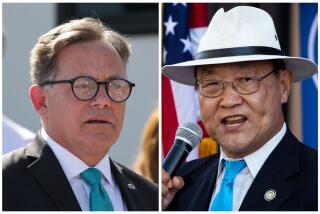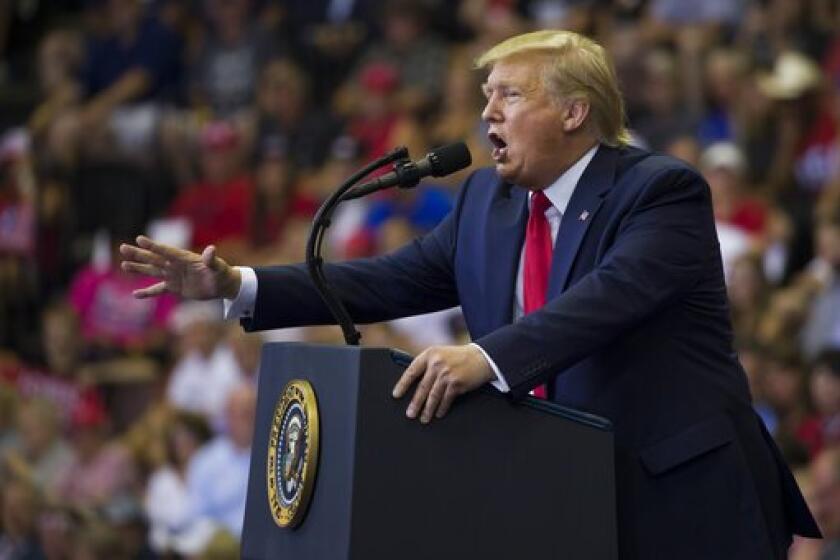Why Unions Rally to Feinstein
- Share via
Unions across the country have stepped up their political activities in an effort to reverse the many legislative defeats they have suffered in recent years under anti-union presidents Ronald Reagan and George Bush and governors such as California’s George Deukmejian.
And the race for governor of California is one of the nation’s most crucial tests this year of labor’s ability to help elect candidates who are not in the Reagan-Bush-Deukmejian mold.
A recent California court ruling has enabled unions to made a dramatic 11th-hour drive to elect their friends on Nov. 6, particularly Dianne Feinstein, the Democratic gubernatorial candidate.
Contributions from individuals and unions and other organizations were sharply limited in 1988 by Proposition 73. Candidates for state and local offices were prohibited from receiving more than $1,000 from individuals and $5,000 from political committees during any fiscal year.
Many other states have similar laws, but three weeks ago, U.S. District Judge Lawrence K. Karlton overturned those limitations in California, and labor, as well as other groups and individuals, quickly began making additional contributions.
The logic of Proposition 73 is flawed. If a union with 50,000 members pools its members’ political contributions of, say, 50 cents each, and donates them to a candidate, it would be breaking the law that limits the union to a $5,000 contribution.
But one wealthy contributor can pony up $1,000, not just 50 cents, then add a few more thousands from other family members and be called a law-abiding political activist.
Most of the money from California unions, which have about 2 million members, is going to Feinstein, whose campaign fund is still less than half the size of that of her Republican opponent, Sen. Pete Wilson.
The added help she is getting from labor as a result of the court ruling won’t bring her close to Wilson’s campaign war chest, which is estimated at well over $25 million.
But the unions’ financial aid is a boon, coming in the last weeks of the campaign when her funds are nearly gone. The unexpected money from labor could total $2 million or more, or about $1 per member. It will allow her to buy added television time so essential for any candidate these days.
A spokesman for Wilson said the senator’s campaign chest is also growing, with strong support from employer groups, but practically none from labor.
Union backing for Feinstein is understandable. From labor’s point of view, Wilson voted wrong 85% of the time during his career in the Senate, according to the AFL-CIO, and he hasn’t indicated any plans to change his anti-labor philosophy if elected governor.
Three samples of Wilson’s Senate votes are probably enough to show why unions oppose him so vigorously:
* Wilson voted against a measure to require most employers to give 60 days’ notice to workers before a mass layoff or plant closure. Although the measure helped both union and non-union workers, a “no” vote was counted as an anti-union one by the labor federation, prime sponsor of the proposal. Congress finally approved the bill.
* He voted against a bill that would have required most employers to provide up to 12 weeks of unpaid leave to care for a new child or seriously ill parents.
* He even voted against a proposal for a minimum-wage increase that was so small it would not have allowed low-income workers to catch up with the increase in the inflation rate since the previous minimum-wage hike in l983.
His anti-labor record in the Senate hasn’t been offset during his campaign for governor. Wilson has indicated that he plans to follow the pattern set by Deukmejian, his strong supporter, who almost invariably sides with big business.
William R. Robertson, head of the Los Angeles Labor Federation, says labor realizes that it made a mistake by not working harder to help Mayor Tom Bradley defeat Deukmejian, and unions are trying to rectify that mistake with an all-out campaign for Feinstein.
Unions did put about $1 million into Bradley’s unsuccessful bid in l988. But that wasn’t much when compared to the $2.5 million labor had to spend on just one initiative that it sponsored to restore California’s much-needed Occupational Health and Safety Agency, which Deukmejian killed by blue-penciling its appropriations.
Unions aren’t making many public pronouncements about their increased support for Feinstein and other candidates sympathetic to labor because some worry that their conservative opponents will attack labor-endorsed candidates as “captives” of unions.
But more dangerous to labor’s future than such an unfair label would be a lack of political activity that would help labor’s conservative foes.
Besides, Wilson will find it hard to make that “union captive” label stick on Feinstein.
Remember, she was opposed by almost all unions in the June primaries, when they endorsed Atty. Gen. John K. Van de Kamp for governor. The strong union support she is now getting stems in large part from labor’s fear of seeing a Deukmejian clone as governor.
Feinstein certainly isn’t anti-union, but labor cannot depend on her as an automatic supporter of its positions.
For instance, one of labor’s major battles in the election is against Proposition 139, the Deukmejian initiative that would make it legal for private employers to hire prisoners for the first time since a Constitutional prohibition against the practice was adopted soon after the Civil War.
Feinstein is supporting the labor-opposed initiative.
Maybe labor’s last-minute support for her campaign will prove to be decisive. If it does, labor may regain some of the reputation it has lost in recent years as a major player on the political battle fields.
More to Read
Get the L.A. Times Politics newsletter
Deeply reported insights into legislation, politics and policy from Sacramento, Washington and beyond. In your inbox twice per week.
You may occasionally receive promotional content from the Los Angeles Times.










